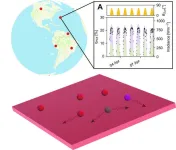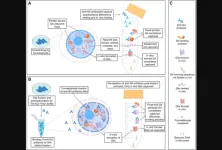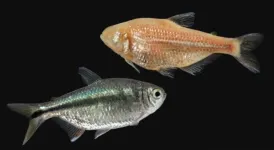(Press-News.org) Scientists are always on the lookout for ways to make our world a better place, and one area they're focusing on is solar energy. One idea in this area is to make solar cells more efficient by concentrating more solar light onto them. While investigating this recently, a group of scientists at the Cavendish Laboratory and AMOLF (Amsterdam NL) have found that improving solar cells efficiency in this way is harder than we might think but have discovered other avenues by which it might be possible to improve solar energy capture anywhere on the planet.
The researchers were interested in finding out if solar cells, devices that turn sunlight into electricity, could be tweaked to perform better in different parts of the world, where concentration of solar light may be higher. To examine this, they used machine learning models and neural networks (AI) to understand how the sun’s radiation would behave in different spots on Earth.
They integrated this data into an electronic model to calculate the solar cells’ output. By simulating various scenarios, they could predict how much energy the solar cells could produce at various locations worldwide.
Their findings published in Joule, however, revealed a surprising twist. “Making solar cells super-efficient turns out to be very difficult. So, instead of just trying to make solar cells better, we figured some other ways to capture more solar energy,” said Dr. Tomi Baikie, first author of the study and Research Fellow at the Cavendish Laboratory and at Lucy Cavendish College. ”This could be really helpful for communities, giving them different options to think about, instead of just focusing on making the cells more efficient with light.”
Imagine solar panels that can flex and fold like origami or become partially transparent to blend seamlessly into surroundings and make them easy to install. By enhancing the durability and versatility of these panels, they could be integrated into a wide range of settings, promising longevity and efficiency.
“We suggest a different plan that can make solar panels work well in lots of different places around the world,” said Baikie. “The idea is to make them flexible, a bit see-through/semi-transparent, and able to fold up. This way, the panels can fit into all kinds of places.”
Furthermore, the researchers advocate the use of patterning the solar capture devices with the aim to optimise their arrangement for maximum sunlight absorption. This approach holds the potential to improve the design of solar arrays, increasing their effectiveness in harnessing solar energy.
“This realisation means that we can now focus on different things instead of just making solar cells work better. In future, we're going to examine solar harvesting pathways that includes tessellation. It's like a puzzle pattern that could help us capture even more sun power,” concluded Baikie.
END
Reimagining the future of solar energy
2024-03-18
ELSE PRESS RELEASES FROM THIS DATE:
Metformin during pregnancy impacts offspring brain development
2024-03-18
With the rise in gestational diabetes and metabolic disorders during pregnancy, metformin is also being prescribed more frequently. Although it is known that the oral antidiabetic agent can cross the placental barrier, the impacts on the brain development of the child are largely unknown. An interdisciplinary research team from the German Institute of Human Nutrition Potsdam-Rehbrücke (DIfE) have now been able to demonstrate in a mouse model that although metformin has positive effects in pregnant animals, it does not in the offspring. The results were published in the specialist ...
Johns Hopkins Medicine-led team develops fluid biomarker for early detection of ALS and FTD
2024-03-18
Two progressively degenerative diseases, amyotrophic lateral sclerosis (ALS, commonly known as Lou Gehrig’s disease) and frontotemporal dementia (FTD, recently in the news with the diagnoses of actor Bruce Willis and talk show host Wendy Williams), are linked by more than the fact that they both damage nerve cells critical to normal functioning — the former affecting nerves in the brain and spinal cord leading to loss of movement, the latter eroding the brain regions controlling personality, behavior and language.
Research studies have repeatedly shown that in patients with ALS or FTD, the function of TAR DNA-binding protein 43, more commonly called TDP-43, ...
A new antibody capture method reveals G-quadruplex landscape and its regulation
2024-03-18
“[...] we present an improved method for G4 landscape determination and by applying it we show that sequence property-specific constraints of the nuclear environment mitigate G4 formation.”
BUFFALO, NY- March 18, 2024 – A new research paper was published in Oncotarget's Volume 15 on March 14, 2024, entitled, “G-quadruplex landscape and its regulation revealed by a new antibody capture method.”
In this new study, researchers Subhamoy Datta, Manthan Patel, Chakkarai Sathyaseelan, Chandrama Ghosh, Akanksha Mudgal, Divyesh Patel, Thenmalarchelvi Rathinavelan, ...
Researchers achieve >99% photoluminescence quantum yield in metal nanoclusters
2024-03-18
Prof. ZHOU Meng’s research team from the University of Science and Technology of China (USTC) of the Chinese Academy of Sciences (CAS), collaborating with Prof. WANG Quanming’s team from Tsinghua University (THU) achieved near-unity room-temperature photoluminescence quantum yield (PLQY) (>99%) in the near-infrared (NIR) emission of metal nanoclusters in solution. Their work was published in Science.
Gold nanoclusters (Au NCs) as NIR-emissive materials hold potential in biomedical applications. However, the PLQY of Au NCs in NIR region is typically low, often ...
Overeating and starving both damage the liver: Cavefish provide new insight into fatty liver disease
2024-03-18
KANSAS CITY, MO—March 18, 2024—Fatty liver, which can lead to liver damage and disease, can occur from both overeating and starvation. Now, new research shows how naturally starvation-resistant cavefish, unlike other animals, are able to protect their liver and remain healthy. The findings have implications for understanding and potentially addressing liver conditions in humans.
Researchers from the Stowers Institute for Medical Research in collaboration with Université Libre de Bruxelles in Belgium and Iowa State University ...
ReseNovel sacrificial layer “super-tetragonal” for freestanding oxide membranes
2024-03-18
A research team led by Prof. WU Wenbing and Prof. WANG Linfei from the University of Science and Technology of China (USTC), in collaboration with Prof. SI Liang’ s team from Northwest University, developed a new water-soluble sacrificial layer, “super-tectragonal” Sr4Al2O7 (SAOT), with broad tunability in lattice constants, which can be used to prepare high-quality freestanding oxide membrane. Their work was published in Science.
Freestanding oxide membrane is a type of low-dimensional quantum material that maintains single-crystal properties even ...
Novel design enhance thermal insulation and impact resistance in composite glass
2024-03-18
A research team led by Prof. NI Yong and Prof. HE Linghui from the University of Science and Technology of China (USTC) of the Chinese Academy of Sciences (CAS) has developed a new composite glass combining the nacre-inspired structure and shear stiffening gel (SSG) material, maintaining transparency while exhibiting excellent thermal insulation and impact resistance. Their work was published in Advanced Materials.
Bulk glass serves as an indispensable structural material in people’s daily lives. However, glass has poor thermal ...
Keeping in touch: Why businesses are cultivating relationships with former employees
2024-03-18
For many people, leaving a job can be like leaving a family — and because of the personal and professional bonds they’ve forged, many naturally stay in touch with their former coworkers and keep apprised of what’s happening in the organization.
But what happens when companies make a concerted effort to bolster those bonds, help former employees in their careers and keep them in the loop? According to new research from the UBC Sauder School of Business, it can have big benefits for both employees and employers.
For the paper, researchers studied ...
Study estimates nearly 70 percent of children under six in Chicago may be exposed to lead-contaminated tap water
2024-03-18
A new analysis led by researchers at the Johns Hopkins Bloomberg School of Public Health estimates that 68 percent of Chicago children under age six live in households with tap water containing detectable levels of lead.
For their analysis, the researchers used machine learning, an artificial intelligence technique, to gauge likely levels of lead in tap water in households across Chicago, based on an existing dataset that includes results from 38,385 tap water tests taken from 2016 to 2023. The tests were from households that had registered for a free self-administered testing service for lead exposure.
The threshold the researchers ...
Rensselaer researcher receives DOE grant to develop models that track the formation of black holes
2024-03-18
When a star goes supernova, a massive burst of neutrinos is the first signal that can escape the density of the collapsing star. Detecting and analyzing this phenomenon in real time would allow us insight into stellar dynamics and, potentially, black hole formation. Detection of these types of signals from modern physics detectors is notoriously hard and presents computational challenges that push the bounds of modern and next-generation computing. Transmitting and analyzing the data from the massive particle physics detectors to the next generation of extreme-scale ...








